check engine light CADILLAC DEVILLE 1993 7.G User Guide
[x] Cancel search | Manufacturer: CADILLAC, Model Year: 1993, Model line: DEVILLE, Model: CADILLAC DEVILLE 1993 7.GPages: 406, PDF Size: 20.78 MB
Page 141 of 406

Downloaded from www.Manualslib.com manuals search engine r
A CAUTION:
Don’t keep driving if the oil pressure is low. If you do, your
engine can become
so hot that it catches fire. You or others
could be burned. Check your oil
as soon as possible and have
your vehicle serviced.
JOTICE:
Damage to your engin %om ne! cte probl
costly and
is not covered by your warranty.
Change Oil Soon Light
This light will come on
for a few seconds as a
bulb check when you
first start your engine.
IS cal
The light will also come on following engine start up for
20 seconds when
either the oil life percentage
is less the 10% or 7500 miles (12500 km)
have been driven. This is a reminder that it is time to change your oil. See -
the Index under “Oil Life Indicator” for more information on this system.
128
Page 142 of 406
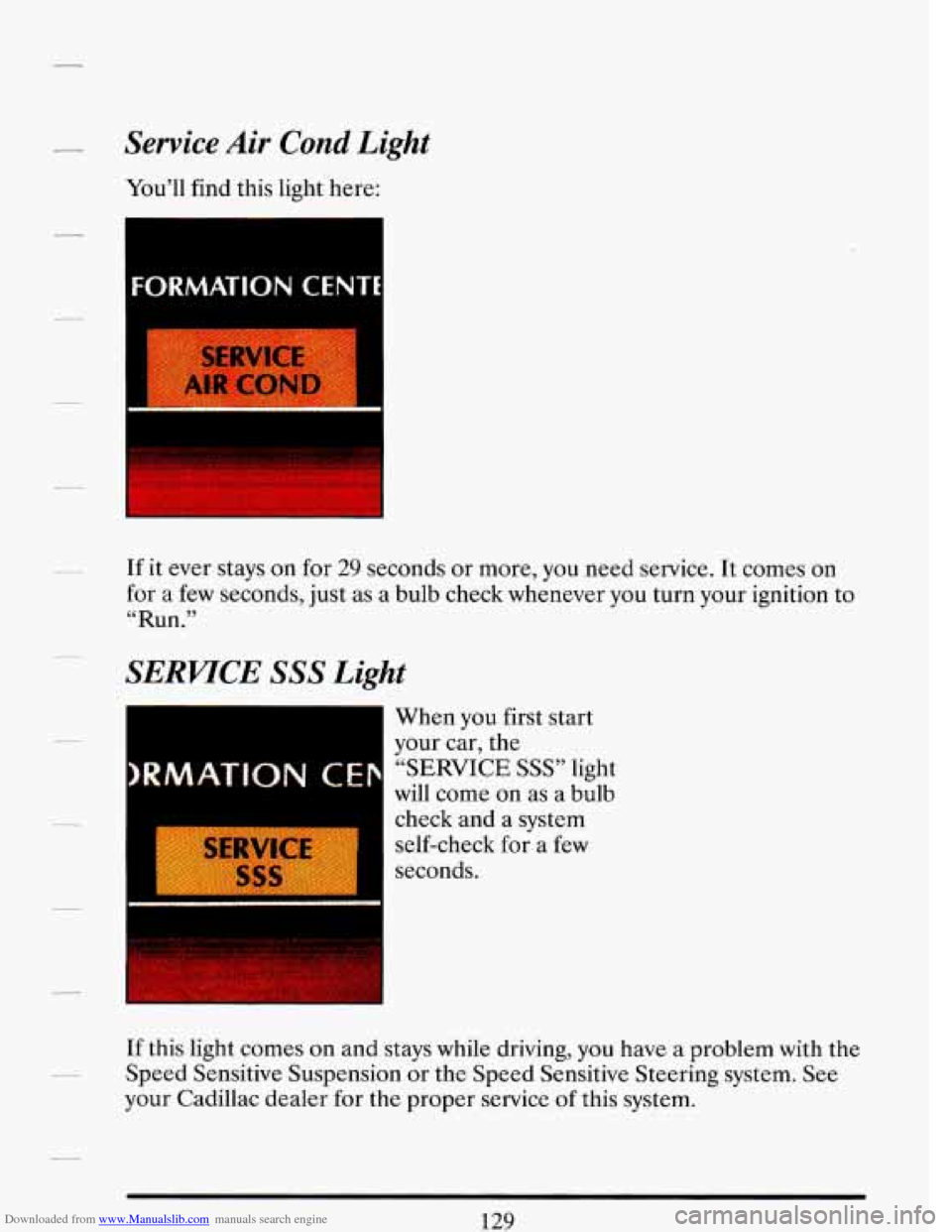
Downloaded from www.Manualslib.com manuals search engine - Service Air Cond Light
You’ll find this light here:
FORMATION CENTE
iERVICE
__ If it ever stays on for 29 seconds or more, you need service. It comes on
for a few seconds, just as a bulb check whenever you turn your ignition to
“ Run. ”
__
SERWCE SSS Light
bRMATION CEP
When you first start
your car, the
“SERVICE SSS” light
will come on as a bulb
check and a system
self-check for a
few
seconds.
If this light comes
on and stays while driving, you have a problem with the
Speed Sensitive Suspension or the Speed Sensitive Steering system. See
your Cadillac dealer for the proper service
of this system.
129
Page 147 of 406

Downloaded from www.Manualslib.com manuals search engine Fwc- ta Center
cl
Press and hold the
Range and Fuel Used
buttons to display the
oil life percentage.
You’ll
see how much oil life you have left, as a percentage. So if you see
“94” for example, that means that the way you’re driving your vehicle,
94%
of your current oil life is still left.
The
“CHANGE OIL SOON” light will come on for a few seconds as a
bulb check when you start your engine. The light will also come on for
20
seconds following engine start-up when either the oil life percentage is
less the
10% or 7,500 miles (12500 km) have been driven. The system
probably will say to change the oil between
3000 miles (5000 km) and
7500 miles (12500 km), but it may even say to change it before 3000 miles
under severe conditions. It all depends on your driving patterns.
(If it
doesn’t,
or if it doesn’t even light up, then something is wrong. You will
need to have it serviced.)
There
are two things the system won’t do: It can’t sense heavy dust in the
places where you drive.
If you drive in a dusty area, you should change
your oil every
3000 miles (5000 km) or 3 months (whichever comes first),
unless the “CHANGE
OIL SOON” light comes on sooner.
It doesn’t check how much oil you have
so you will still have to check for
that.
To check it, see the Index under “Engine Oil.”
When You’ve Changed the Oil
When new oil is put in, you’ll need to reset your system. To do that, press
and hold the “Range” and “Reset” buttons between
5 and 60 seconds.
-
L. c
Page 208 of 406

Downloaded from www.Manualslib.com manuals search engine - High Beams
If the vehicle approaching you has its high beams on, signal by flicking
yours to high and then back to low beam. This is the usual signal to
lower
the headlight beams. If the other driver still doesn’t lower the beams,
resist the temptation to put your high beams on. This only makes
two
half-blinded drivers.
7
On a freeway, use your high beams only in remote areas where you won’t
impair approaching drivers. In some places, like cities, using high beams
is illegal.
When you follow another vehicle on
a freeway or highway, use low
beams. True, most vehicles now have day-night mirrors that enable the
__ driver to reduce glare. But outside mirrors are not of this type and high
beams from behind can bother the driver ahead.
A Few More Night Driving Suggestions
Keep your windshield and all the glass on your vehicle clean -- inside and
out. Glare at night is made much worse by dirt on the glass. Even the
inside
of the glass can build up a film caused by dust. Tobacco smoke also
makes inside glass surfaces very filmy and can be a vision hazard if it’s left
there.
Dirty glass makes lights dazzle and flash more than clean glass would,
making the pupils
of your eyes contract repeatedly. You might even want
to keep a cloth and some glass cleaner
in your vehicle if you need to clean
- your glass frequently.
Remember that your headlights light up far less
of a roadway when you
are in a turn or curve.
Keep your eyes moving; that way, it’s easier to pick out dimly lighted
objects.
Just as your headlights should be checked regularly for proper aim,
so
should your eyes be examined regularly. Some drivers suffer from night
blindness
-- the inability to see in dim light -- and aren’t even aware of it.
195
Page 214 of 406

Downloaded from www.Manualslib.com manuals search engine CITYDlUPTNG
One of the biggest problems with city streets is the amount of traffic on
them. You’ll want to watch out for what the other drivers are doing and
pay attention to traffic signals.
Here are ways to increase your safety in city driving:
0
0
0
Know the best way to get to where you are going. Try not to drive
around trying to pick out a familiar street or landmark. Get
a city map
and plan your trip into an unknown part
of the city just as you would
for a cross-country trip.
Try to use the freeways that rim and crisscross most large cities. You’ll
save time and energy.
(See the next section, “Freeway Driving.”)
Treat a green light as a warning signal.
A traffic light is there because
the corner is busy enough to need it. When a light turns green, and
just before you start
to move, check both ways for vehicles that have
not cleared the intersection
or may be running the red light.
Page 215 of 406

Downloaded from www.Manualslib.com manuals search engine Obey all posted speed limits. But remember that they are for ideal
road, weather and visibility conditions. You may need to drive below
the posted limit in bad weather or when visibility is especially poor.
Pull to the right (with care) and stop clear of intersections when you
see or hear emergency vehicles.
FREEWAYDWNG
Mile for mile, freeways (also called thruways, parkways, expressways,
turnpikes, or superhighways) are the safest
of all roads. But they have
their own special rules.
The most important advice on freeway driving is: Keep up with traffic and
keep to the right. Drive
at the same speed most of the other drivers are
driving. Too-fast
or too-slow driving breaks a smooth traffic flow. Treat
the left lane
on a freeway as a passing lane.
Entering the Freeway
At the entrance there is usually a ramp that leads to the freeway. If you
have a clear view
of the freeway as you drive along the entrance ramp,
you should begin to check traffic. Try to determine where you expect to
blend with the
flow. If traffic is light, you may have no problem. But if it is
heavy, find a gap as you move along the entering lane and time your
approach.
Try to merge into the gap at close to the prevailing speed.
202
Page 216 of 406
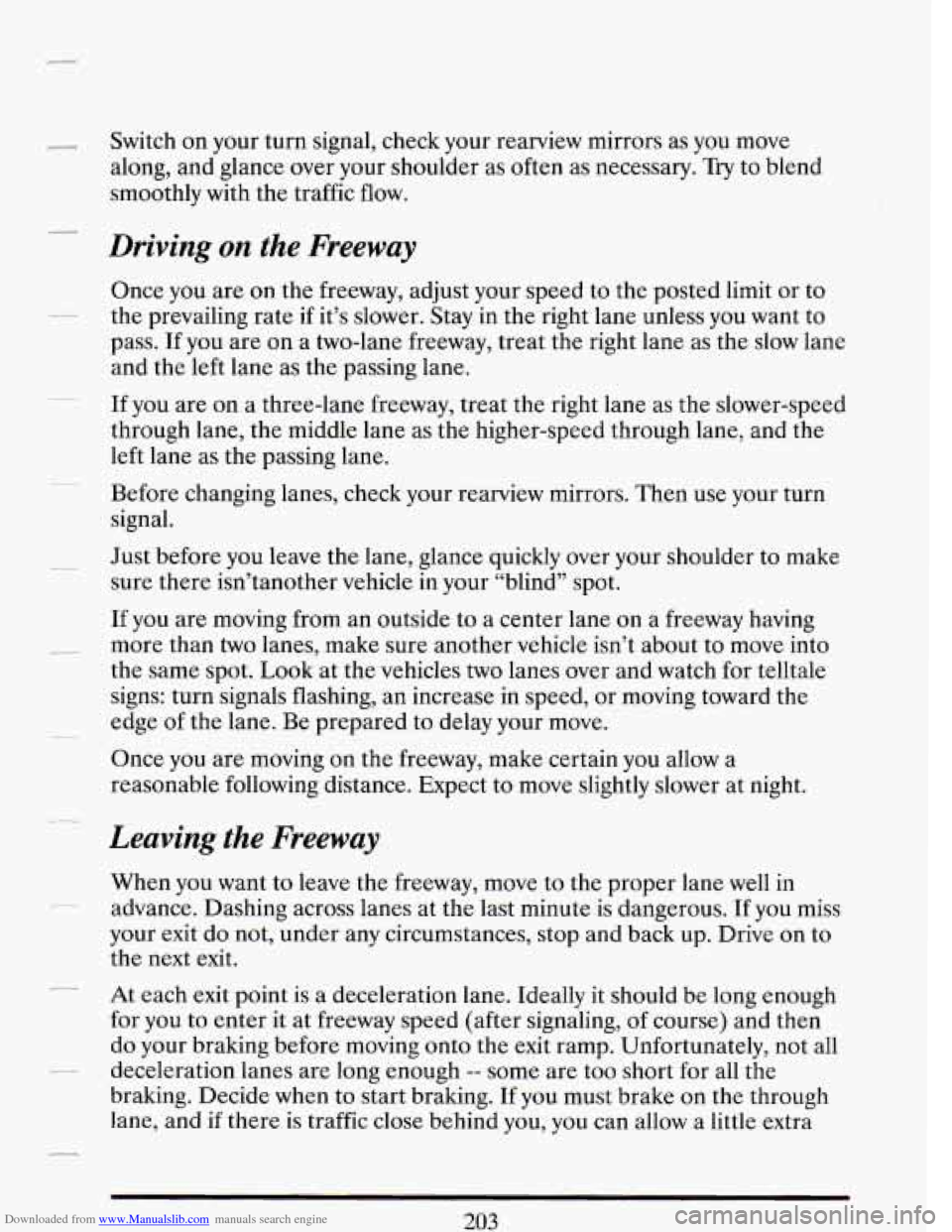
Downloaded from www.Manualslib.com manuals search engine Switch on your turn signal, check your rearview mirrors as you move
along, and glance over your shoulder as often as necessary.
Try to blend
smoothly with the traffic
flow.
Driving on the Freeway
Once you are on the freeway, adjust your speed to the posted limit or to
the prevailing rate if it’s slower. Stay in the right lane unless you want to
pass. If you are on
a two-lane freeway, treat the right lane as the slow lane
and the left lane as the passing lane.
If you are on a three-lane freeway, treat the right lane as the slower-speed
through lane, the middle lane as the higher-speed through lane, and the
left
lane as the passing lane.
Before changing lanes, check your rearview mirrors. Then use your turn
signal.
Just before you leave the lane, glance quickly over your shoulder to make
sure there isn’tanother vehicle in your “blind” spot.
If you are moving from an outside to a center lane on a freeway having
more than two lanes, make sure another vehicle isn’t about to move into
the same spot.
Look at the vehicles two lanes over and watch for telltale
signs: turn signals flashing, an increase in speed, or moving toward the
edge
of the lane. Be prepared to delay your move.
Once
you are moving on the freeway, make certain you allow a
reasonable following distance. Expect to move slightly slower at night.
Leaving the Freeway
When you want to leave the freeway, move to the proper lane well in
advance. Dashing across lanes at the last minute is dangerous. If you miss
your exit do not, under any circumstances, stop and back up. Drive on to
the next exit.
At each exit point is a deceleration lane. Ideally it should be long enough
for you to enter it at freeway speed (after signaling,
of course) and then
do your braking before moving onto the exit ramp. Unfortunately, not all
deceleration lanes are long enough
-- some are too short for all the
braking. Decide when to start braking. If you must brake
on the through
lane, and if there
is traffic close behind you, you can allow a little extra
203
Page 217 of 406
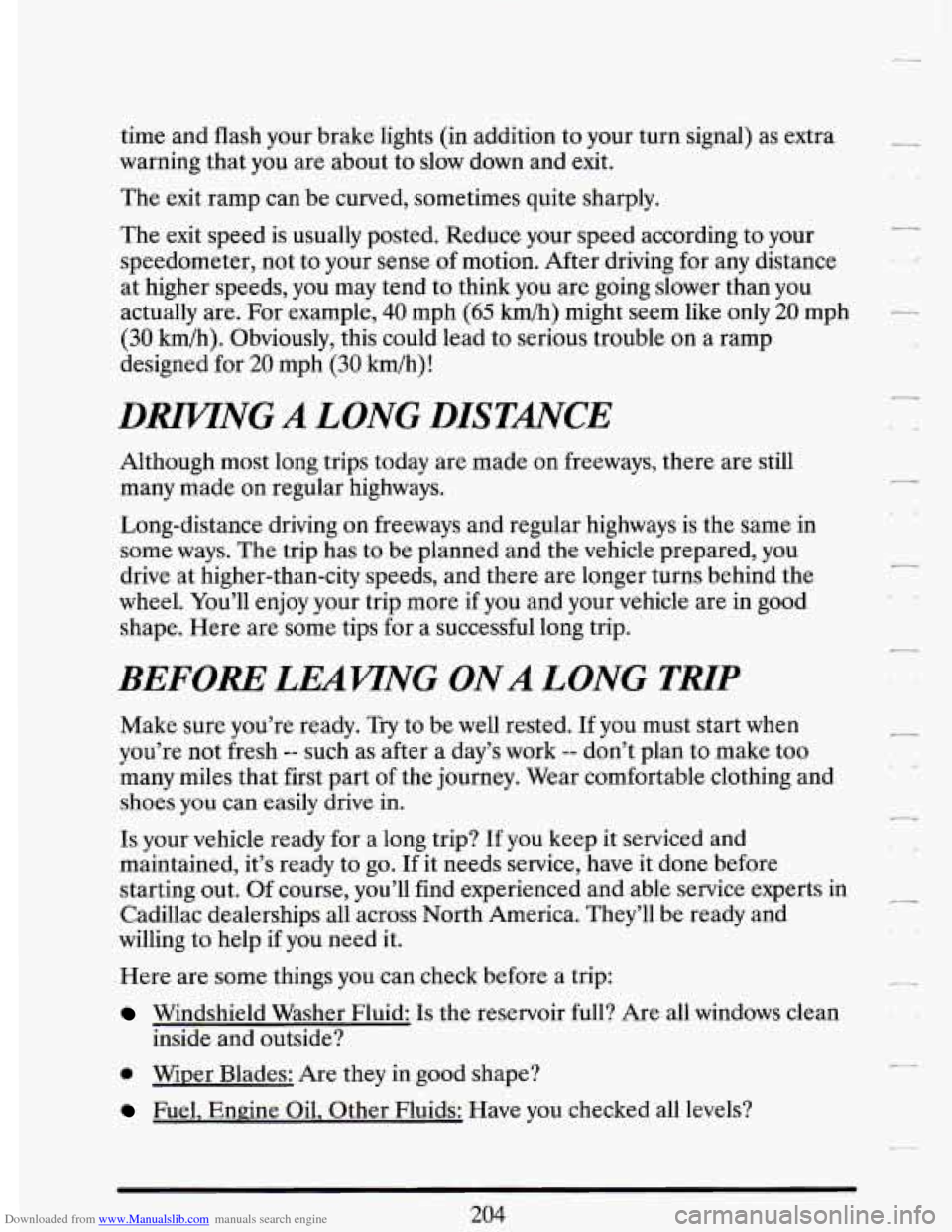
Downloaded from www.Manualslib.com manuals search engine time and flash your brake lights (in addition to your turn signal) as extra
warning that you are about to slow down and exit.
The exit ramp can be curved, sometimes quite sharply.
The exit speed is usually posted. Reduce your speed according to your
speedometer, not to your sense
of motion. After driving for any distance
at higher speeds,
you may tend to think you are going slower than you
actually are. For example,
40 mph (65 kmh) might seem like only 20 mph
(30 krn/h). Obviously, this could lead to serious trouble on a ramp
designed
for 20 mph (30 km/h)!
DmNG A LONG DISTANCE
Although most long trips today are made on freeways, there are still
many made
on regular highways.
Long-distance driving on freeways and regular highways is the same in
some ways. The trip has to be planned and the vehicle prepared, you
drive at higher-than-city speeds, and there are longer turns behind the
wheel. You’ll enjoy your trip more if you and your vehicle are in good
shape. Here are some tips for a successful long trip.
BEFORE LEAWNG ONA LONG TMP
Make sure you’re ready. Try to be well rested. If you must start when
you’re not fresh
-- such as after a day’s work -- don’t plan to make too
many miles that first part of the journey. Wear comfortable clothing and
shoes you can easily drive in.
Is your vehicle ready for a long trip? If you keep it serviced and
maintained, it’s ready to go. If it needs service, have it done before
starting out.
Of course, you’ll find experienced and able service experts in
Cadillac dealerships all across North America. They’ll be ready and
willing to help if you need it.
Here are some things you can check before a trip:
Windshield Washer Fluid: Is the reservoir full? Are all windows clean
inside and outside?
0 Wiper Blades: Are they in good shape?
Fuel, Engine Oil, Other Fluids: Have you checked all levels?
c
204
Page 219 of 406
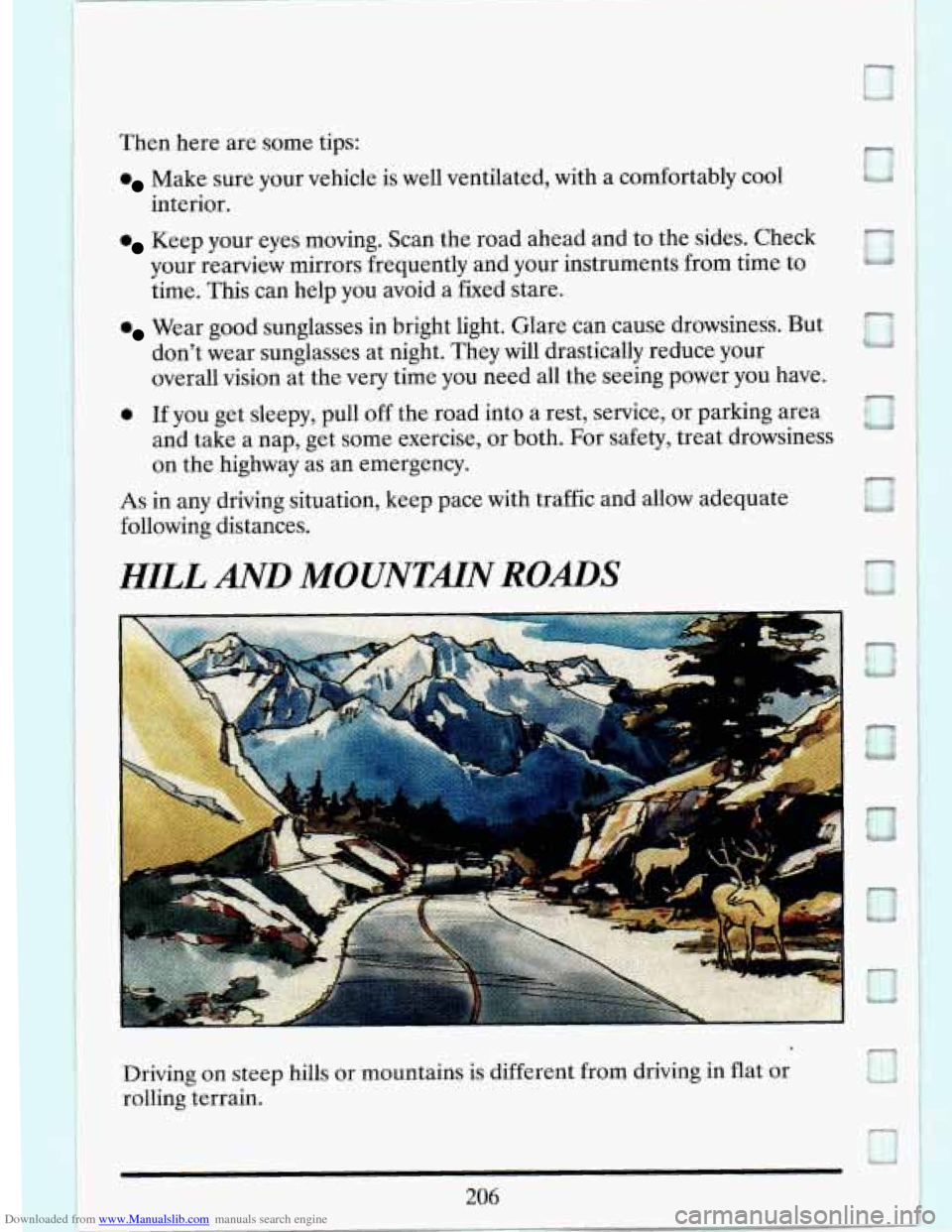
Downloaded from www.Manualslib.com manuals search engine Then here are some tips:
Make sure your vehicle is well ventilated, with a comfortably cool
interior.
Keep your eyes moving. Scan the road ahead and to the sides. Check
your rearview mirrors frequently and your instruments from time to
time. This can help you avoid a fixed stare.
Wear good sunglasses in bright light. Glare can cause drowsiness. But
don't wear sunglasses
at night. They will drastically reduce your
overall vision at the very time you need all the seeing power you have.
0 If you get sleepy, pull off the road into a rest, service, or parking area
and take a nap, get some exercise, or both. For safety, treat drowsiness
on the highway as an emergency.
As in any driving situation, keep pace with traffic and allow adequate
following distances.
HILL AND MOUNTMN ROADS
U
Driving on steep hills or mountains is different from driving in flat or
rolling terrain.
Page 229 of 406
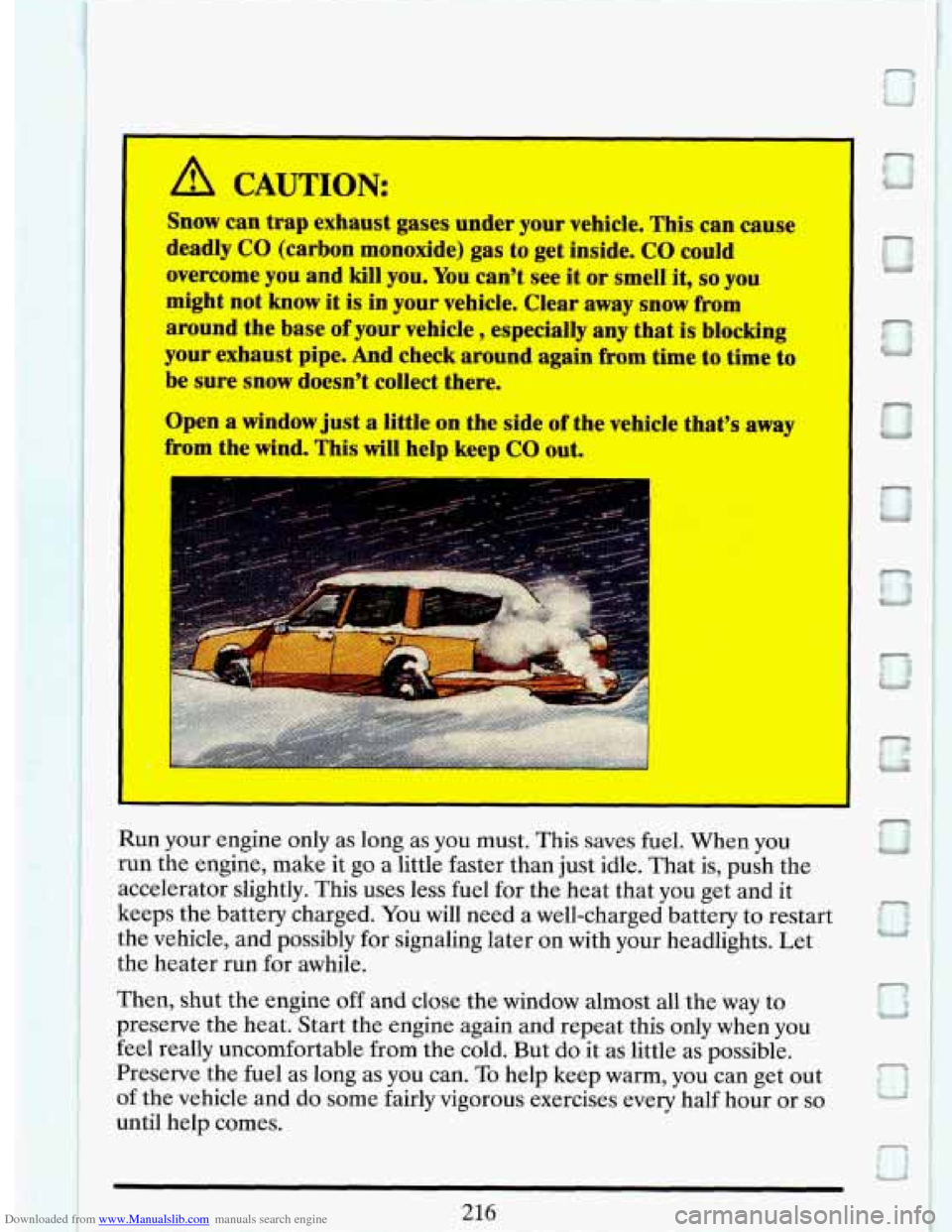
Downloaded from www.Manualslib.com manuals search engine I
I
A CAUTION:
Snow can trap exhaust gases under your vehicle. This can cause
deadly
CO (carbon monoxide) gas to get inside. CO could
overcome you and kill you. You can’t see it or smell it,
so you
might not know it is in your vehicle. Clear
away snow from
around the base of your vehicle
, especially any that is blocking
your exhaust pipe. And check around again from time to time to
be sure snow doesn’t collect there.
Open a window just
a little on the side of the vehicle that’s away
from the wind. This will help keep CO out.
Run your engine only as long as you must. This saves fuel. When you
run the engine, make it go a little faster than just idle. That is, push the
accelerator slightly. This
uses less fuel for the heat that you get and it
keeps the battery charged. You
will need a well-charged battery to restart
the vehicle, and possibly for signaling later on with your headlights. Let
the heater run for awhile.
Then, shut the engine off and close the window almost all the way to
preserve the heat. Start the engine again and repeat this only when you
feel really uncomfortable from the cold. But do it as little as possible.
Preserve the fuel as long as you can. To help keep warm, you can get out
of the vehicle and do some fairly vigorous exercises every half hour or so
until help comes.
a
ID
216
1